It’s time of the full rendition of “The Twelve Days of Christmas”!
On the twelfth day of Christmas, my true love sent to me,
Twelve drummers drumming,
Eleven pipers piping,
Ten Lords a-leaping,
Nine Ladies dancing,
Eight maids a-milking,
Seven swans a-swimming,
Six geese a-laying,
Five gold rings,
Four calling birds,
Three French hens,
Two turtle doves,
And a partridge in a pear tree.
I’m going to take a bit of poetic licence with this one, so that I can call attention to this enchanting embroidered panel entitled The Musicians, as well as a number of other textiles and fashion pieces connected to music, as opposed to drums specifically.
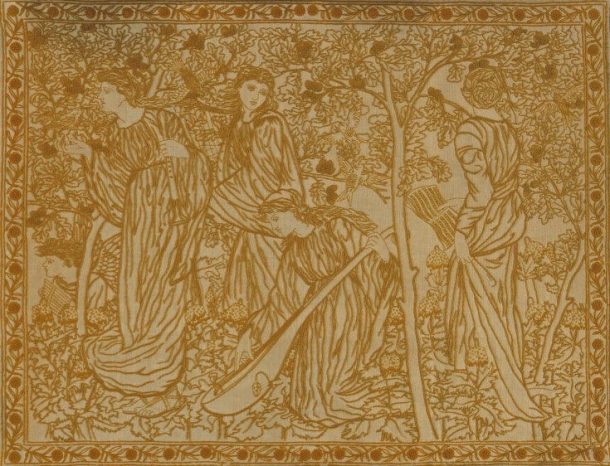
The design was previously attributed to Edward Burne-Jones and William Morris. British artist and designer Burne-Jones was thought to have created the figures, while Morris was said to have been responsible for the decorative details. But Selwyn Image, an Englishman most famous for his stained glass windows, is now known to have designed this panel, which was embroidered at the School of Art Needlework around 1879. All three men, as well as the School of Art Needlework, were connected to the Arts and Crafts movement, which I discussed in the second blog of this series, and this panel is a classic, as well as especially lovely, example of the work produced by this movement.
The Musicians would have taken contemporaries back in time, and away from the industrial centres hated by men and women part of the Arts and Crafts movement, and the associated Pre-Raphaelite and aesthetic movements. And the scene has an otherworldly feel. The women’s dresses are a cross between Greek chitons and contemporary aesthetic dress—a retaliation against mainstream Victorian womenswear inspired largely by Pre-Raphaelite and aesthetic art, itself inspired by the past, ancient Greece included. Image’s panel can be seen to promote this dress reform, which was becoming increasingly popular in artistic circles by the late 1870s. Further, Image has chosen to depict instruments, including a harp and pan flute, which originated in ancient or pre-Victorian times. And the woodland setting has a sense of timelessness, while the figures, women and an angel, seem mythological and heavenly respectively.
In terms of colour, the shades used are subtle, like those deployed by other Arts and Crafts designers including Morris, and importantly the linen panel has been embroidered by hand, using various wools and an impressive range of techniques. The French knots used to form the tops of the acorns and the centres of the flowers along the border are particularly striking.
Partly because of all the techniques used on this panel, this is one of those objects which has a very different impact when it’s seen firsthand. It was a real wow moment when I opened the drawer in which this panel is stored. I hope that I’ve been able to capture something of this experience in the photographs below, which were taken close up and from an angle in order to highlight the variety of colours, materials, and techniques used. The Musicians is roughly one by one and a half metres.
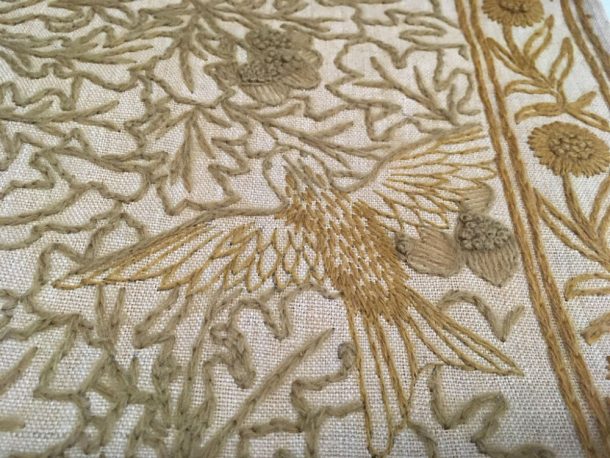

The musical theme, particularly Image’s choice of gentle instruments like the harp, adds to the sense of enchantment too, I think. Music has inspired many textiles and fashion designers over the years, whether because of its ability to sooth and provoke a range of emotion, its flowing quality, or its ties to popular culture, or for other reasons altogether. Below are a number of our objects connected to this theme. All of them apart from the casket and pattern book (which are at the Museum) are currently here at Clothworkers’, and we have numerous other caskets and pattern books available to be viewed during appointments.
Embroidered casket T.432-1990, produced by Martha Edlin in 1671

Pattern book T.219-1992, manufactured by Bianchini-Férier, 1920-1921

Rhythm furnishing fabric T.1035-2000, made by Warner and Sons in 1967
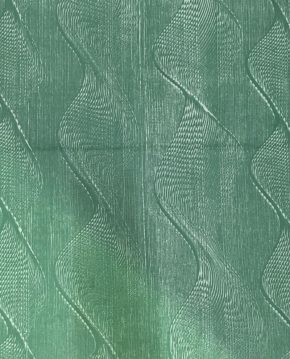
Jumper T.171-1984, designed by Corgi for Mr Freedom, 1968-1970
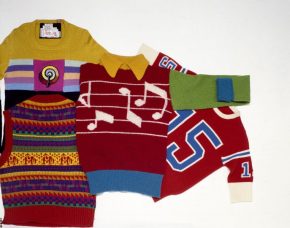
Chuck Berry dress fabric CIRC.443-1974, designed by Christopher Snow for Slick Brands Ltd. in 1974
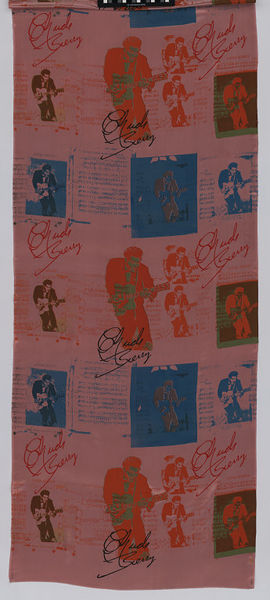
given to the Museum by Christopher Snow, Esq., © Victoria and Albert Museum, London
Looking for a musical instrument – wearing a paradox ensemble T.272 to G-1989, designed by Lun-na Menoh in 1989
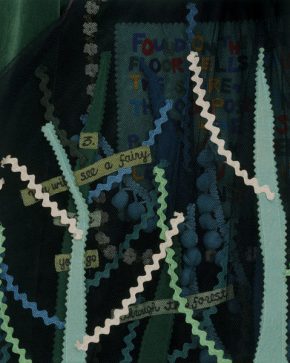
Top and skirt T.109:1,2-2016, designed by James Jean for Prada in 2008
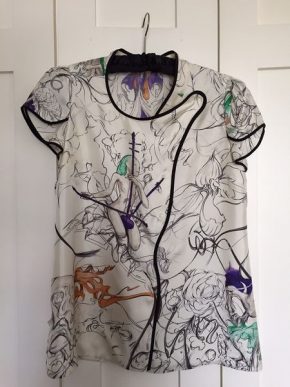
If you’re interested in making an appointment to view textiles and fashion objects at the Clothworkers’ Centre, please email clothworkers@vam.ac.uk.

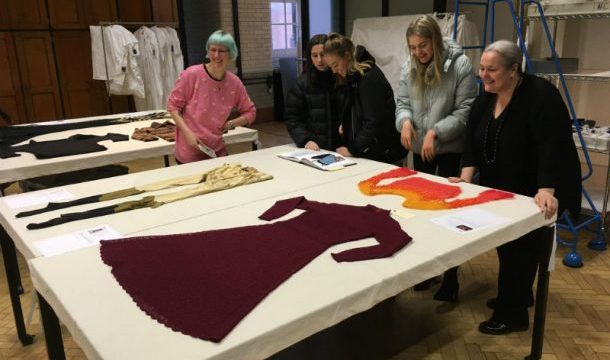
Cool caskets and pattern books
This is good
Your share is the great knowledge I have gathered, you are an important person I admire, thank you